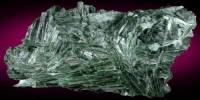Almandine, formula- [Fe32+ Al2 Si3 O12], is the ferrous iron end member of the class of garnet minerals representing an important group of rock-forming silicates, which are the main constituents of the Earth’s crust, upper mantle, and transition zone. It is the most is the most lustrous of the Garnets and has several gemstone varieties.
Almandine is a species of mineral belonging to the garnet group. The term Garnet describes a group name for several closely related minerals that form important gemstones, and Andradite is an individual member mineral of the Garnet group. Almandine is one end-member of a mineral solid solution series, with the other end member being the garnet pyrope. Magnesium substitutes for the iron with increasingly pyrope-rich composition.
The name is a corruption of alabandicus, which is the name applied by Pliny the Elder to a stone found or worked at Alabanda, a town in Caria in Asia Minor. Almandine is an iron alumina garnet, of deep red color, inclining to purple. It is frequently cut with a convex face, or en cabochon, and is then known as the carbuncle. Viewed through the spectroscope in a strong light, it generally shows three characteristic absorption bands.

General Information:
- Category: Nesosilicate
- Formula: Fe32+ Al2 Si3 O12
- Crystal system: Cubic
- Crystal class: Hexoctahedral (m3m)
Occurrence
Almandine occurs rather abundantly in the gem-gravels of Sri Lanka, whence it has sometimes been called Ceylon-ruby. When the color inclines to a violet tint, the stone is often called Syriam garnet, a name said to be taken from Syriam, an ancient town of Pegu (now part of Myanmar). Large deposits of fine almandine-garnets were found, some years ago, in the Northern Territory of Australia, and were at first taken for rubies and thus they have known in the trade for some time afterward as Australian rubies.
Identification
lmandine is the iron aluminum garnet. Magnesium can substitute for the iron and become more like pyrope, the magnesium aluminum garnet.
- Color: reddish orange to red, slightly purplish red to reddish purple and usually dark in tone
- Cleavage: none
- Fracture: conchoidal
- Mohs scale hardness: 7 – 7.5
- Luster: greasy to vitreous
- Streak: white
- Specific gravity: 4.05 (+.25, -.12)
- Polish luster: vitreous to subadamantine
- Optical properties: Single refractive, and often anomalous double refractive
- Refractive index: 1.790 (+/- .030)
- Birefringence: none
- Pleochroism: none
- Dispersion: .024
Andradite is a common mineral but is usually opaque and not fit for gemstone use; the transparent gemmy forms are rare and valued. The term Andradite is strictly a mineral term and is rarely used in the gem market. The gem forms of Andradite are known by their variety names of Demantoid, Topazolite, and Melanite.
Information Source:
















